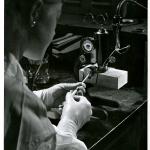Another Obstacle for Women in Science: Men Get More Federal Grant Money

For ambitious young scientists trying to start their own research labs, winning a prestigious grant from the National Institutes of Health can be career making.
But when it comes to the size of those awards, men are often rewarded with bigger grants than women, according to a study published Tuesday in JAMA, which found that men who were the principal investigators on research projects received $41,000 more than women.
The disparity was even greater at the nation’s top universities. At Yale, women received $68,800 less than men, and at Brown, the median disparity was $76,500. Over all, the median N.I.H. award for female researchers was roughly $126,600, compared with $167,700 for men.
The study, by researchers at Northwestern University, confirms longstanding disparities between men and women in the field of science. In recent years, a cavalcade of studies has documented biases that favor male researchers in hiring, pay, prize money, speaking invitations and even the effusiveness displayed in letters of recommendation.
“It’s disappointing, but identifying the problem is a step toward solving the problem,” said Cori Bargmann, a neuroscientist who runs the $3 billion science arm of the Chan Zuckerberg Initiative, a philanthropic organization, and who was not involved in the study.
In a statement, the N.I.H. did not dispute the study’s findings and said it was working to address the funding disparities and, more broadly, the gender inequities that bedevil women in the field.
“We have and continue to support efforts to understand the barriers and factors faced by women scientists and to implement interventions to overcome them,” it said.
Only one in five applicants for an N.I.H. grant lands one, an achievement that can be crucial in whether a young researcher succeeds or drops out of the field.
“That first grant is monumentally important and determines your trajectory,” said Carolina Abdala, a head and neck specialist at the University of Southern California, who won her first N.I.H. grant in 1998. “It can help get you on the tenure track and it gets you into that club of successful scientists who can procure their own funding, which makes it easier to change jobs.”
But the size of the grant can also be important in determining the scale and ambition of a junior researcher’s first lab. Teresa K. Woodruff, a co-author of the JAMA study, said that having less money put women at a disadvantage, making it harder to hire graduate students and buy lab equipment.
“It means women are working harder with less money to get to the same level as men,” said Dr. Woodruff, a researcher at the Northwestern University Feinberg School of Medicine. “If we had the same footing, the engine of science would move a little faster toward the promise of basic science and medical cures.”
The study analyzed 54,000 grants awarded from 2006 to 2017 and used key benchmarks to ensure recipients were at similar points in their careers. Among the top 50 institutions funded by the N.I.H., the researchers found that women received median awards of $94,000 compared with $135,000 for men. At the Big Ten schools, including Penn State, the University of Michigan and Northwestern, female principal investigators received a median grant of $66,000 compared with $148,000 for men.
There was one exception to the pattern; in a curious twist, the study found that women who were applying for individual research grants received nearly $16,000 more than male applicants. Dr. Woodruff noted that such grants made up only 11 percent of N.I.H. grant money, but said more research was needed into funding disparities.
Andrew Jacobs, a reporter with the Health and Science desk of The Times based in New York, previously reported from Beijing and Brazil. He also worked as a Metro reporter, with stints at the Style section and the National desk, covering the American South. His reporting for The Times has included such varied topics as the presidential campaign, the aftermath of the earthquake in China and the lead up to the 2008 Summer Olympics.
